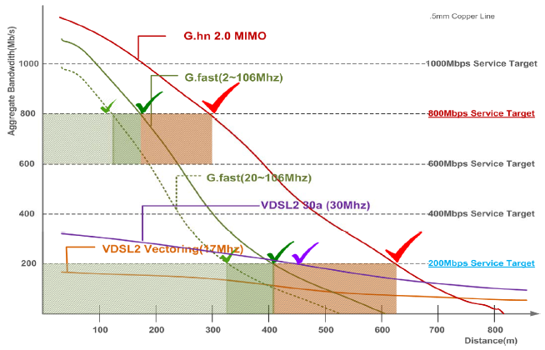Your basket is currently empty!
G.hn (Gigabit Home Network) is a recognized name for the most advanced type of home networking technology. Its basic technical standards, G.9960 and G.9961, were developed by the Internationale Fernmeldeunion (ITU) and promoted by the HomeGrid Forum and other organizations.
Instead of high-quality Ethernet cables, G.hn uses all types of telephone and coax cables as well as power lines for data transmission and achieves comparable speeds. The standard is designed for the transmission of all types of Ethernet packets. It can be used flexibly – even on the “last mile” for Internet connections.
Use for home networking
The idea behind G.hn technology is that home networking can be done using the telephone and TV cables that are usually available, instead of having to equip the building with new Ethernet lines at high labor and cost. G.hn technology is easy to use – even for private consumers and technical laymen
Use in the telecommunication industry
The potential of G.hn technology was recognized early on by leading telecommunications companies in Asia and the USA. They founded the industry association GIGAWire Alliance to promote the development of hardware based on G.hn for distribution of fiber optic connections in buildings. Korea Telecom (KT), which dominates South Korea, is particularly active and successful in using this technology (also known as G.now). This country has the highest percentage of fiber connections in international comparison, thanks in part to the use of G.hn technology. Meanwhile, GIGAWire Alliance and HomeGrid Forum have merged.
The G.hn approach is not entirely new, by the way. It is the successor to HomePNA – a standard developed between 1990 and 2009 for home networks via telephone and TV cabling. HomePNA achieved data rates of up to 320Mbit/s and was used extensively in the USA as well as some other countries. Many former HomePNA supporters now support G.hn.
The most important features of G.hn Wave2 from the user’s point of view are:
- Physical data rate 1.7 Gbit/s (download + upload). At application level – 1.5 Gbit/s.
- Download and upload rates are freely configurable, symmetrical data rates are possible.
- Compatibility with IPv4 and IPv6.
- Any type of telephone and coaxial cables can be used.
- Data transmission via telephone cable can be carried out using the SISO (1 wire pair) and MIMO (2 wire pairs) methods.
- Transmission rates of 1 Gbit/s at application level are possible with coaxial cables up to approx. 800 meters, via telephone cables up to approx. 250 meters (MIMO) or approx. 150 meters (SISO).
- Connectivity up to approx. 1800 meters (coaxial cable) or 800 meters (telephone cable) given.
- Used frequency spectrum 2-200 MHz (coax and telephone SISO) or 2-100 MHz (telephone MIMO), individual ranges can be blocked if required.
- Coexistence with ADSL (no overlap of frequency ranges) and VDSL (due to low signal level of G.hn).
Advantages of G.hn Wave2 compared to other technologies
Commercial Value:
- Fast and inexpensive implementation (no need for rewiring)
- Fast ROI (low investment costs)
- Standardized technology
- Many reference projects worldwide
High performance:
- Very fast transmission (up to 1.7 Gbit physical data rate. 1.5 Gbit on application level.)
- Very stable and secure connection (based on cables)
- Wide coverage (distance >500 meters)
- Performance comparison with VDSL and G.fast



